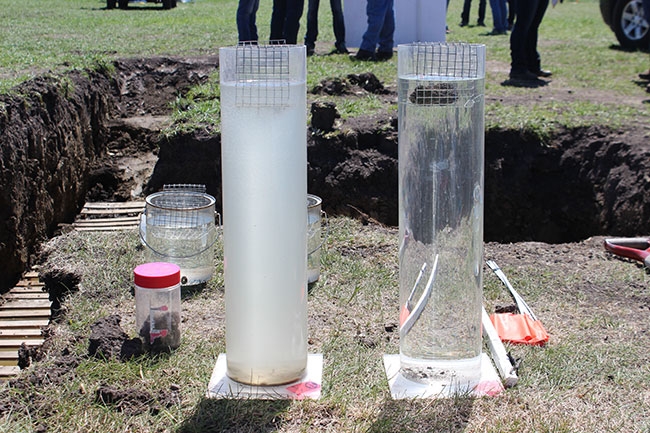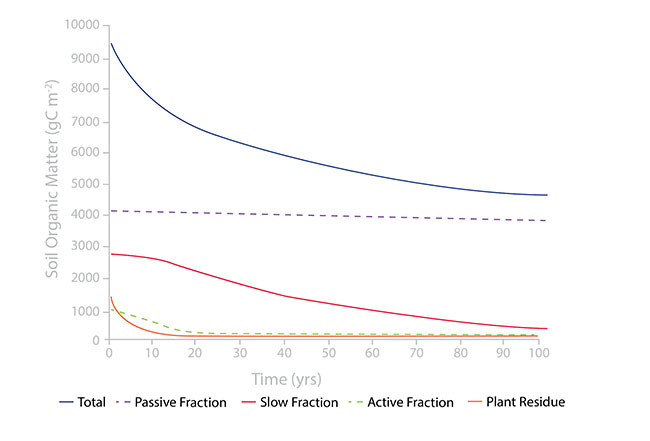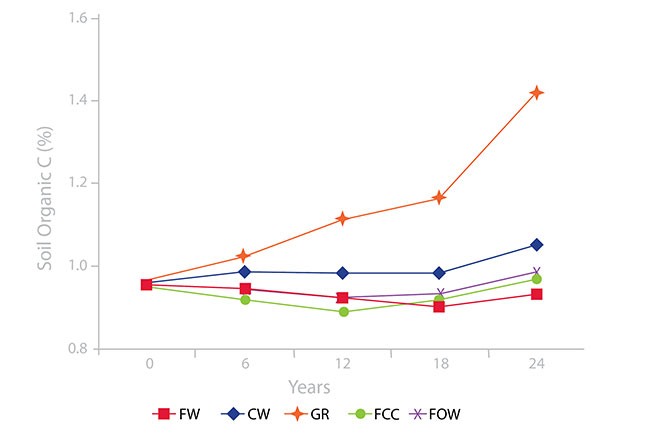
Features
Agronomy
Soil
Understanding soil organic matter in the Prairies
Organic matter (OM) in soil is the result of hundreds to several thousand years of microbial, plant and animal residue additions to the soil. Soil organic residues are constantly breaking down and are in various stages of decomposition.
September 8, 2017
By Ross H. McKenzie PhD P.Ag.
 The column of water on the right has a suspended lump of soil from grassland and the column on the left has a lump of soil from the adjacent cultivated field. The soil from the cultivated field disintegrated rapidly while the lump from grassland soil remained intact three hours later. This simple demonstration shows the benefit of no tillage and increased soil organic matter to bind soil particles into good soil structure. Organic matter (OM) in soil is the result of hundreds to several thousand years of microbial
The column of water on the right has a suspended lump of soil from grassland and the column on the left has a lump of soil from the adjacent cultivated field. The soil from the cultivated field disintegrated rapidly while the lump from grassland soil remained intact three hours later. This simple demonstration shows the benefit of no tillage and increased soil organic matter to bind soil particles into good soil structure. Organic matter (OM) in soil is the result of hundreds to several thousand years of microbialAfter years of soil formation and development, the OM level in soil reaches a steady state or equilibrium. The amounts and types of OM in a soil are strongly influenced by climatic factors, which, in turn, are dictated by the native vegetation growth that contributed to OM additions to soil. Landscape and geographic location also plays an important role in soil formation and OM additions to soil on upper, mid and lower slope positions.
Soils vary in organic matter content. Cultivated soils in the drier regions of the Prairies in the Brown soil zone typically have two to three per cent organic matter, while those in the Dark Brown soil zone have three to five per cent OM and those in the Black soil zone have six to 12 per cent OM. Cultivated soils in the Gray soil zone have one to three per cent organic matter.
Organic matter plays many important roles in soil and has many positive effects on soil properties (both physical and chemical).
Much of the OM in soil exists as humus. This is the dark matter formed by soil microbes after the breakdown of plant residues and is chemically complex. Humus adheres to clay particles to bind soil minerals into a good granular structure. Humus is very stable and decays very slowly over hundreds of years. This is the material that gives soil its brown or black colour; the colour of the soil depends on the amount of humus in it. Soil OM is also made up of living biomass, which includes plant roots and soil microbes. This is the living part of soil. Soil microbes cycle and release carbon (C) and nutrients back to the soil for re-use by plants.
Soil OM is a major source of soil carbon. The terms soil organic matter and soil organic carbon are often used interchangeably. The C content of OM varies, but on the Prairies it is about 56 per cent. The following equation is used to estimate the total organic matter content of soil from soil organic C measurements:
% Organic Matter = % Organic Carbon x 1.78
Some soil testing labs determine soil organic C content to calculate an estimated percentage of soil organic matter. Soil OM plays a major role in the global carbon cycle and is a major sink and source of carbon.
Tillage and cropping system effects on soil organic matter
After Prairie soils were broken and developed for cultivated agriculture until the 1960s, the crop-fallow rotation system was widely used. Summerfallow was utilized to store valuable soil moisture and control weeds. But, over time, it was recognized that summerfallow in a crop rotation had very negative effects that caused soil quality and soil organic matter to slowly decline.
Summerfallow leaves the soil idle for a growing season. This results in increased soil moisture. Frequent tillage aerated the summerfallowed soil to stimulate microbial activity, resulting in accelerated soil organic matter breakdown and nutrient release. In the fallow year, there are no plants growing to contribute to the soil organic mater pool. Figure 1 shows the effect of the wheat-fallow rotation on four soil organic matter fractions over 100 years of cropping. The four organic matter fraction levels shown include: plant residue (one to five years to break down), active fraction (five to 20 years to break down), slow fraction (20 to 100 years to break down), and passive fraction (100 to more than 1,000 years to break down).
Using a crop-fallow rotation resulted in the decline of soil carbon by up to 50 per cent in Prairie soils over 50 to 100 years (Figure 1). The plant residue, active and slow carbon fractions were most affected, but the passive fraction (very stable organic matter) was relatively unaffected by cultivation. Soil organic nitrogen level declined by up to 60 per cent. This widely used cropping system relied on mineralization of nutrients stored in OM for crop nutrition. Summerfallow coupled with tillage also exposed soil to erosion by tillage, water and wind. Some of the worst wind erosion events on the Prairies occurred in the 1930s, when the crop-fallow system was commonly used. The crop-fallow system had very negative effects on soil quality after Prairie grasslands were broken and developed for annual crop production.
Fortunately, in the past 20 to 30 years, many Prairie farmers have shifted to continuous cropping, more diverse crop rotations, direct seeding of crops and have started using adequate rates of fertilization. The interaction of these practices has been very positive, starting the process of increasing soil organic matter levels, which, in turn, is improving soil quality. This soil conservation system has had many benefits and the negative effects of summerfallow on OM levels are eliminated.
Direct seeding ensures tillage is greatly reduced or eliminated to maintain a protective cover of residues from previous crops on the soil surface. This greatly reduces water and wind erosion and conserves more soil moisture for future crops. Most important is the fact that plant residues are added to the soil every year and the rate of decay of organic materials is much slower with the elimination of summerfallow. By cropping the land every year, organic residues are produced every year to maintain and hopefully increase soil OM levels compared to the old wheat-fallow system. Applying optimum rates of fertilizers ensures optimum crop yields and provides increased crop residue return to soil. Returning more residues to the soil can increase OM content. Eventually, well-managed soils will reach a new soil organic matter equilibrium or steady state level.
Figure 2 shows the change in soil organic carbon in a long-term crop rotation study in the Brown soil zone near Bow Island, Alta., after 24 years. I initiated the study in 1992 and ran the trials until 2013, when I retired. Plots seeded to permanent grass had the greatest increase in soil organic carbon, followed by continuous wheat treatments. The increases in organic carbon were modest but significant. Much of the added OM in the soil is referred to as light fraction OM that mineralizes at moderate rates to release plant available nitrogen (N), phosphorus (P), sulphur (S) and other nutrients for the growing crops.
 Figure 2: Impact of cropping system on soil organic C concentration in the top foot of soil (N fertilized treatments) (FW fallow-wheat; CW continuous wheat; GR grass; FCC fallow-wheat-wheat; FOW fallow-oilseed-wheat).
Figure 2: Impact of cropping system on soil organic C concentration in the top foot of soil (N fertilized treatments) (FW fallow-wheat; CW continuous wheat; GR grass; FCC fallow-wheat-wheat; FOW fallow-oilseed-wheat).
Benefits of increasing soil organic matter
There are many benefits to increasing soil OM. Organic matter improves soil’s physical structure by acting like a glue to bind soil mineral particles together into a good granular or crumb structure. This increases water infiltration rates, making it easier for water to penetrate into soil and, in turn, increase the amount of soil water stored for future crop growth. The improved granular structure makes soil more resistant to wind and water erosion (see photo on page 22). Soil organic matter acts a bit like a sponge to increase soil water holding capacity.
Organic matter is a very important storage reservoir for nutrients in organic form that are gradually released into inorganic form for plant uptake and micro-organism use. Organic matter is particularly important for storing N, as soil significant amounts of N are normally only present in soil in OM. In healthy top soil, about half of all the P and most of the S is stored in organic form in soil OM.
Soil organic matter will increase the cation holding capacity (the ability to hold positively charged elements) of soil to bind and hold inorganic nutrients like potassium (K+), calcium (Ca++) and magnesium (Mg++) in the soil. Organic matter also helps to buffer soil against changes in soil pH.
Humus gives the soil a darker colour, which helps enhance absorption of the sun’s energy. Darker soils warm up a bit more quickly in spring, which in turn stimulates microbial activity. Warmer soils will stimulate more rapid crop germination and emergence.
In recent years, soil organic matter’s ability to absorb potential pollutants or toxins such as pesticides has been recognized. Soil organic matter provides a place where toxins are temporarily adsorbed and stored until micro-organisms can gradually degrade these materials over time.
Organic matter impacts on crop production
Soil organic matter directly and indirectly influences many soil quality factors and agronomic factors to benefit crop production. Soil organic matter has tremendous positive benefits for soil physical qualities, such as structure and tilth for better root growth, water infiltration and water storage.
Most important, soil organic matter serves as an excellent storehouse of slow-release nutrients to increase the fertility of the soil. Depending on the level of soil organic matter, and soil moisture and temperature during the growing season, soils can mineralize and release up to 80 pounds of N per acre during the growing season. Significant amounts of P and S can also be mineralized and contribute to crop nutrition.
In summary, organic matter contributes considerably to improved soil quality. To increase soil organic matter, farmers need to continuous crop, use diverse crop rotations, minimize or eliminate tillage, fertilize for optimum yield and return all crop residues. The interaction of these factors will help to maintain or even increase soil organic matter. Farmers should also consider using perennial forages in their crop rotations, as they are very effective for maintaining or building soil organic matter levels.